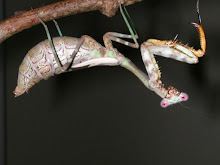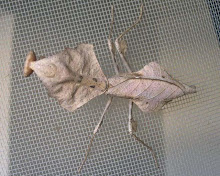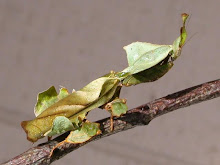 While the nymphs are small it is best to feed them small insects such as fruit flies, aphids or micro crickets. It is always a good idea to have a supply of these ready for when you receive your nymph (size of food depends on age of nymph ordered). Its best to feed them as much as they will eat, but you must be careful as I've heard that their abdomen can bust if over fed.
While the nymphs are small it is best to feed them small insects such as fruit flies, aphids or micro crickets. It is always a good idea to have a supply of these ready for when you receive your nymph (size of food depends on age of nymph ordered). Its best to feed them as much as they will eat, but you must be careful as I've heard that their abdomen can bust if over fed.As the nymphs grow, they can move onto larger foods such as crickets, locus, wax worms, meat flies and other insects. The mantis can easily take prey as large as themselves and of their own species. Remember any creepy crawly is food for the mantis.
 Try to vary the food given as much as possible, too much of the same food (mainly crickets) can make the mantis weak. Any uneaten food should be taken out of the container due to the mantis being venerable while sheading. This also includes any half-eaten dead insects, as mould can form on these.
Try to vary the food given as much as possible, too much of the same food (mainly crickets) can make the mantis weak. Any uneaten food should be taken out of the container due to the mantis being venerable while sheading. This also includes any half-eaten dead insects, as mould can form on these. 

+2.jpg)
+1.jpg)







.jpg)
.jpg)
.jpg)